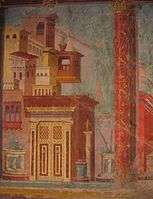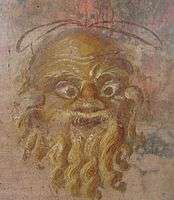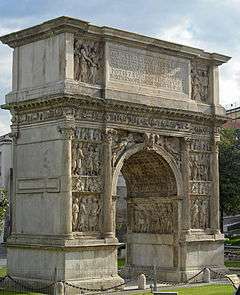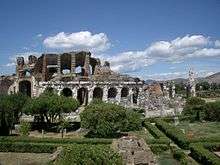Villa Boscoreale
|
Boscoreale Villa, view from above. | |
| Location | Boscoreale, Province of Naples, Campania, Italy |
|---|---|
| Region | Magna Graecia |
| Coordinates | 40°45′41″N 14°28′17″E / 40.761389°N 14.471389°ECoordinates: 40°45′41″N 14°28′17″E / 40.761389°N 14.471389°E |
| Type | Dwelling |
| Site notes | |
| Management | Soprintendenza Speciale per i Beni Archeologici di Pompei, Ercolano e Stabia |
| Website | Sito Archeologico di Boscoreale (Italian) |

Villa Boscoreale (Italian pronunciation: [ˈvilla boskoˈreaːle]) is an ancient Roman villa located in the town of Boscoreale, about one and a half kilometers north of Pompeii, southeast of Vesuvius, in Campania, southern Italy. This area was a hunting reserve and also used agriculturally, specializing in wine and olive oil.[1] Evidence in tablets and graffiti shows that the house was probably built in the 1st century (around 40-30) BC.[2] The villa was largely destroyed and entirely buried by the eruption of Mount Vesuvius in AD 79. It was privately discovered, excavated, partially dismantled and reburied in 1900. Its auctioned images exist in a number of museums, internationally.
Ownership
Ownership of the villa has been contested. While there is no doubt P. Fannius Synistor did reside there, excavated bronze tablets show another name, that of Lucius Herennius Florus . Many things were marked with seals in ancient Rome to indicate possession. It is believed that since the tablet with the letters "L. HER. FLO" on the front of it was found inside the villa, it must serve as a mark of villa ownership.[3] These two are the only confirmed owners in the early 1st century BC and 1st century AD. However, there may have been an earlier owner before them. For clarity, the house is referred to as being owned by P. Fannius Synistor.[4]
Art

The Villa is most notable for its now auction-scattered artistic works, notably its highly skilled buon fresco paintings. Villa Boscoreale was uncovered in 1900, revealing upon excavation many delineating nuances of luxurious Roman life. The Metropolitan Museum of Art, together with King's College, London, is building a virtual model of the Villa, linking these scattered works, based on a plan drawn at the time of excavation by archaeologist Felice Barnabei (1902)—who also made extensive notes—photographs taken of the excavation, the research of Phyllis W. Lehmann (1953), and axonometric drawings of the plan, locating the images on the walls, by Maxwell Anderson (1987). The construction consisted of a rustic villa of three stories, complete with baths, an underground passage to a stable and agricultural buildings, the latter not excavated. On the Barnabei plan, the central ground floor of the living quarters—the only remains partially intact—consisted of over thirty rooms or enclosures, surrounding, by a peristyle walk, a colonnaded courtyard. The building featured an impressive main entrance approached by five broad steps leading to a colonnaded forecourt.[5]
Most of the representational work has characteristics of Greek, Hellenism or Classicism. For instance, those found in the living room appear to be depictions of either philosophers, such as Epicurus, Zeno or Menedemus, or possibly old kings, like King Kinyras of Cyprus.[6] Similarly, the bedrooms described in Second Style also evoke Hellenistic qualities, such as are seen at the Tomb of Lyson or at Kallikles.[7] At a time when the Roman Republic was ending and classicism somewhat fading, this is considered as an interesting comment on style and taste. Seemingly, Greek representations in the home were considered acceptable, even admired and sophisticated.[8] The images survived the quick succession of Vesuvian cataclysms because of the skill of the fresco work and the absence of organic materials such as indigo, murex purple, red madder among its pigments. The reddening of some of its yellow ochre shows temperatures to have exceeded 300 °C.[9]"
Metropolitan Museum cubiculum reconstruction
The fullest actual reconstruction from original materials at present is of a bedroom (cubiculum diurnum), one of the holdings of the Metropolitan Museum since 1903, and since 2007 a feature of the new Roman Gallery. It consists of most of a newly cleaned and reconstructed set of walls entirely painted in highly accomplished fresco.[10] These spacious Roman Second Style murals represent their walls as open above socle or dado height, except for the architraves above and a few columns that, together with those other features, frame vividly colored architectural views of buildings, columns, landscape, garden scenes, religious statues, beyond, emphasizing expansion and grandeur, but including no humans and only a few birds on the short, window wall. This is also the technique in other, unreconstructed, rooms. For example, In another bedroom, known as Room M, the frescoes depict columns that appear to expand into another room, giving the sense of a much larger, almost unending, space. The facing long walls (19 ft or 5.8 m) of the Metropolitan cubiculum are mirror images of each other, possibly by transfer, with variations. In addition, each is divided into four panels by depicted columns.
Distance in these paintings is built up through a series of orthogonal architectural surfaces, and indicated by overlap occlusion, foreshortening, diminution, pronounced aerial perspective, but without vanishing points. Modelling is indicated by side-shading with slight, selective cast shadow. Pompeian red in front planes, contrasting with the blue tone of the fainter, further planes, provides an additional effective cue for depth. The room had one, north-facing, outside window, through which pyroclastic flows from Vesuvius appear to have entered. As part of the sophisticated depictive scheme, the dado or lower parts of the walls are depicted as themselves, but in First Style. Ledges and niches there show near objects: "metal and glass vases on shelves and tables appearing to project out from the wall", playfully belying the common impression that perspective is always for depicting recession from the picture plane.[11] In other parts of the Villa there are brightly colored nonfigurative walls, in First Style, some of which are on display at the Metropolitan and the Louvre Museum.
Gallery
 Architectural detail of 2d panel of original east wall, cubiculum, Metropolitan Museum
Architectural detail of 2d panel of original east wall, cubiculum, Metropolitan Museum Closer detail showing treatment of orthogonal edges and color
Closer detail showing treatment of orthogonal edges and color A winged genius, from the peristyle
A winged genius, from the peristyle Silenus mask from garland in exedra
Silenus mask from garland in exedra A silver mirror depicting Leda and the swan, part of the Boscoreale Treasure, found at the Villa della Pisanella
A silver mirror depicting Leda and the swan, part of the Boscoreale Treasure, found at the Villa della Pisanella
Notes
- ↑ Hornblower, Simon and Antony Spawforth. Oxford Classical Dictionary. London: Oxford University Press, 1996. 254.
- ↑ "The Villa of P. Fannius Synistor at Boscoreale." The Metropolitan Museum of Art Bulletin Winter 1987-88: 17-36.
- ↑ Milne, Margerie J. "A Bronze Stamp from Boscoreale." The Metropolitan Museum of Art Bulletin 09. 1930: 188-190.
- ↑ "The Villa of P. Fannius Synistor at Boscoreale" p. 18
- ↑ Bettina Bergmann et al., Roman Frescoes from Boscoreale: The Villa of Publius Fannius Synistor in Reality and Virtual Reality (Metropolitan Museum of Art Bulletin 62.4 [Spring 2010]). This, the most recent work on the Villa, is the main source for information not otherwise attributed.
- ↑ "The Villa of P. Fannius Synistor at Boscoreale" p. 29
- ↑ "The Villa of P. Fannius Synistor at Boscoreale" p. 31
- ↑ "The Villa of P. Fannius Synistor at Boscoreale" p. 31
- ↑ Rudolf Meyer, “The Conservation of the Frescoes from Boscoreale in the Metropolitan Museum, in Roman Frescoes from Boscoreale.
- ↑ "The Villa of P. Fannius Synistor at Boscoreale" p. 17
- ↑ "The Villa of P. Fannius Synistor at Boscoreale" p. 21
Further Reading:
- Phillipe De Montebello (1994). The Metropolitan Museum of Art Guide. New York: Metropolitan Museum of Art.
Sources
- Hornblower, Simon; Antony Spawforth (1996). Oxford Classical Dictionary. London: Oxford University Press. p. 254. ISBN 0-19-866172-X.
- Milne, Margerie J. (1930). "A Bronze Stamp from Boscoreale". The Metropolitan Museum of Art Bulletin. The Metropolitan Museum of Art. 25 (09): 188–190. doi:10.2307/3255709. JSTOR 3255709.
- "The Villa of P. Fannius Synistor at Boscoreale". The Metropolitan Museum of Art Bulletin. 45 (3): 17–36. Winter 1987–1988. doi:10.2307/3269140.
- Bettina Bergmann et al., Roman Frescoes from Boscoreale: The Villa of Publius Fannius Synistor in Reality and Virtual Reality (Metropolitan Museum of Art Bulletin 62.4 [Spring 2010])
External links
![]() Media related to Villa of Boscoreale at Wikimedia Commons
Media related to Villa of Boscoreale at Wikimedia Commons
- https://sites.google.com/site/ad79eruption/boscoreale/villa-of-publius-fannius-synistor
- The Metropolitan Museum of Art Guide, a collection catalog from The Metropolitan Museum of Art containing information on Villa Boscoreale (page 325)
- Romano-Campanian Wall-Painting


